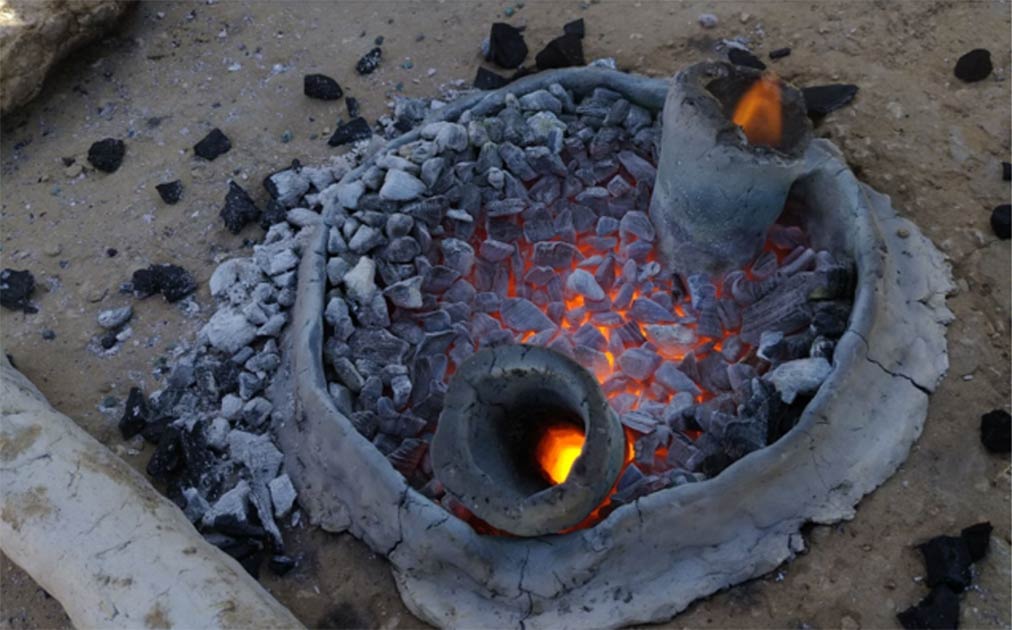Hi-tech Metal Furnace of the Negev Alchemists Incinerates History
Evidence of a “leap forward” in metallurgy has been discovered at a 6,500 years old site in Beersheba in the Negev Desert of southern Israel. This story begins in 2017 when archaeologists in Israel excavated 6,500-year-old copper smelting workshops, which were powered with the earliest-known metal furnaces. This kind of advanced metal furnace replaced the use of smaller, more portable, crucibles for heating ore to extract metal. In a recent press release, Professor Erez Ben-Yosef of the Institute of Archaeology at Tel Aviv University, said the newly uncovered advanced metal furnace represents “the high tech of the period,” and that an elite group of “magicians” used their metallurgy secrets to make symbolic, ritualistic artifacts.
Advanced Metal Furnace Made Copper Smelting Easier
Metallurgy emerged across the southern parts of the Middle Eastern world in the second half of the 5th millennium BC and during the “Chalcolithic period” of the 4th and 3rd millennia BC. This late stage of the Neolithic period was when weapons and tools were first forged from copper. A new study published in the Journal of Archaeological Science explains that prior to a modern neighborhood expansion in Beersheba the Ghassulian culture settlement at Horvat Beter was excavated. Horvat Beter is the old name of Beersheba.

The advanced metal furnace excavation site near the modern-day city of Beersheba, Israel. (Talia Abulafia / Israel Antiquities Authority)
During the Beersheba pre-building survey, an extremely ancient advanced metal furnace for copper smelting and copper slag were discovered, said Talia Abulafia, site excavation director for the Israel Antiquities Authority. Professor Ben-Yosef told the Times of Israel that the recent discovery of larger, in-ground furnaces, at Beersheba indicate a technological evolution from smelting with smaller portable pottery crucibles to a two-step smelting process within industrialized workshops run by “highly specialized craftsmen that produced pure copper ingots and some ceremonial objects.”
The Competition For Ancient Copper Production Dominance
The new paper explains that raw copper ore was mined 100 kilometers (62 miles) from the Horvat Beter settlement, in Jordan ’s mineral-rich Wadi Faynan. Then the Horvat Beter metal production specialists turned the raw copper ore into ingots which were then made into ceremonial artifacts at a separate location. The researchers conducted an elemental analysis of 14 crucible fragments, 18 presumed-furnace fragments, and 26 pieces of slag. Professor Ben-Yosef told The Times of Israel that copper production required a sophisticated knowledge of temperature control, mineral mixture and many other parameters and that the end result “was like magic.”

Some of the crucible fragments and copper slag pieces found at the advanced metal furnace excavation site in southern Israel. (Anat Rasiuk / Israel Antiquities Authority)
A result or outcome that was like magic suggests the work of ancient alchemists. The builders of this advanced metal furnace recently discovered in Israel were similarly organized. Professor Ben-Yosef said the Beersheba craftsmen were an “elite segment of the fledgling societal hierarchy” who operated in “guild-like clusters” that carefully “guarded their workshop’s secrets.” Medieval European alchemists worked in secret groups and kept their finds secret
Moreover, various crucible sizes were discovered at the site, which indicates competition among more than one workshop to perfect or improve the new copper smelting technology. It would seem that each copper smelting workshop had its own “special recipe,” which was not shared with neighboring competitors.

Re-creating the advanced metal furnace of Horvat Beter is just one of the experiments undertaken by Central Timna Valley (CTV) Project of Tel Aviv University (The Institute & Department of Archaeology at Tel Aviv University)
The Negev Desert Treasure Cave Of Chalcolithic Artifacts
The advanced metal furnace was the first stage in a better copper production process and soon these specialist metal workers were able to make fine copper beads and a base for copper paint. Dr Ben-Yosef believes that some of the “pristine utilitarian objects” made in these ancient high-tech workshops were imitations of stone tools that were still commonly used during this era, and that the knock-offs would have been used in ceremonies or for exhibit as social status symbols.
- Earliest Writing System May Have Been Developed by Ancient Metalworkers 6,000 Years Ago
- Only 11 Tribes of Israel? Controversial Findings Reveal Danites Might Not Be Sons of Israel But Sons Of Greece
- How Ancient Woodworkers Sculpted Civilization
In most stories where ancient production workshops are discovered the writer can only end by saying things like “and maybe one day archaeologists will find one of these 6,500-year-old copper treasures.” But this event already happened in 1960 when archaeologists exploring a small seasonal stream in the Judean Desert found the Nahal Mishmar Cave of the Treasure where they unearthed a hoard of rare Chalcolithic artifacts including some 400 advanced metallic objects which were likely made in the revolutionary metal furnaces of Horvat Beter (present-day Beersheba).
Top image: Re-creating the advanced metal furnace of Horvat Beter is just one of the experiments undertaken by Central Timna Valley (CTV) Project of Tel Aviv University. Source: The Institute & Department of Archaeology at Tel Aviv University
By Ashley Cowie




















Comments
Hello Ashley,
You're article indicates to me what type of metal did Ancient Israel use when crafting abominations idol's during Israel's days when they engaged in Apostasy. Rebelling against The Covenant & against God.
Hello Ashley,
You're article indicates to me what type of metal did Ancient Israel use when crafting abominations idol's during Israel's days when they engaged in Apostasy. Rebelling against The Covenant & against God.